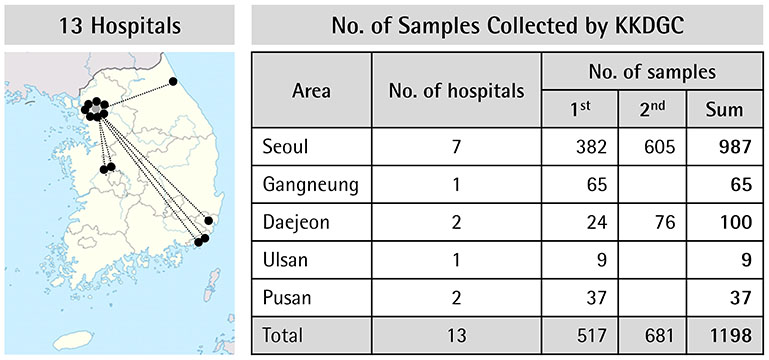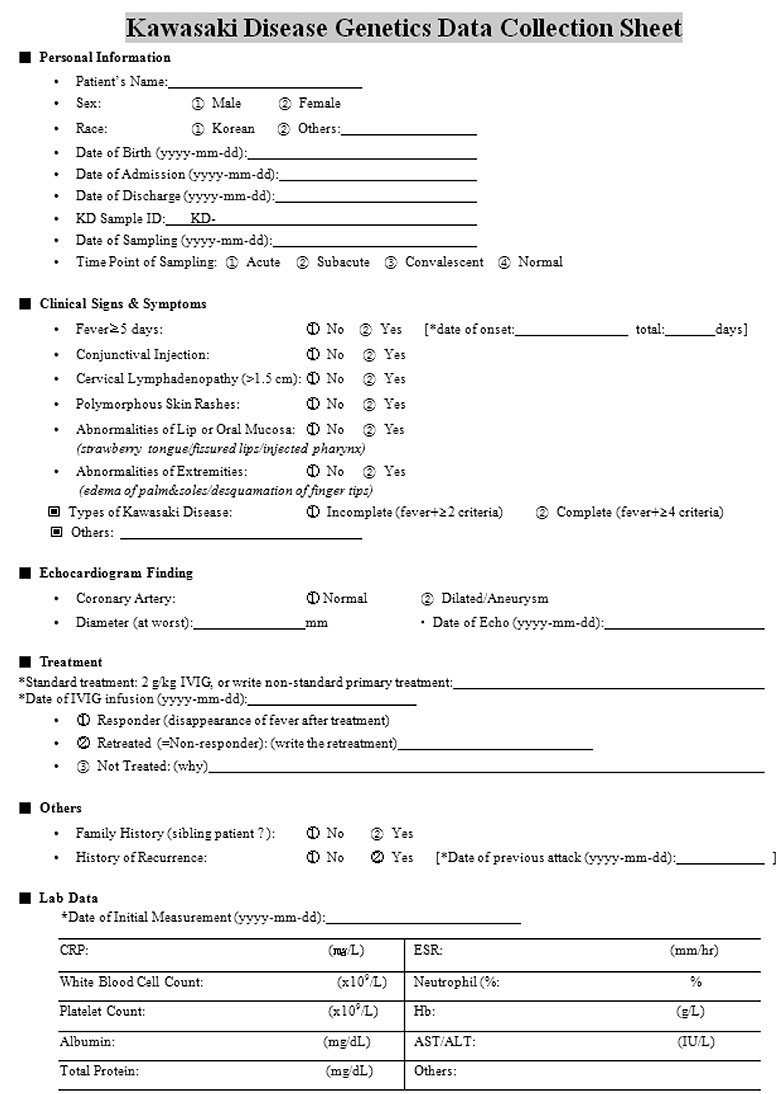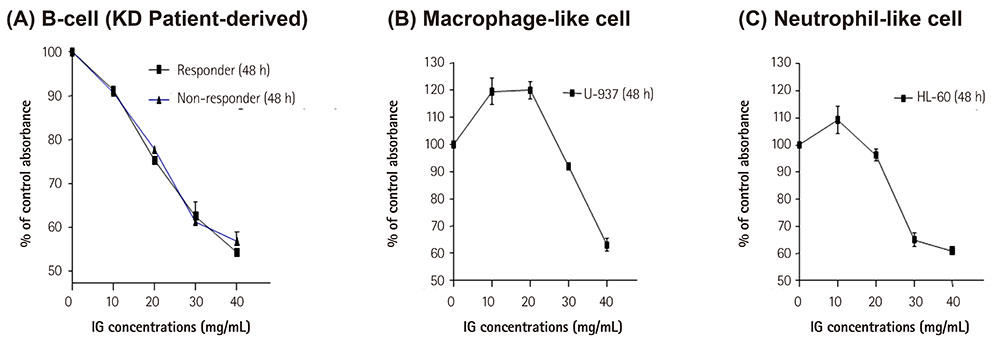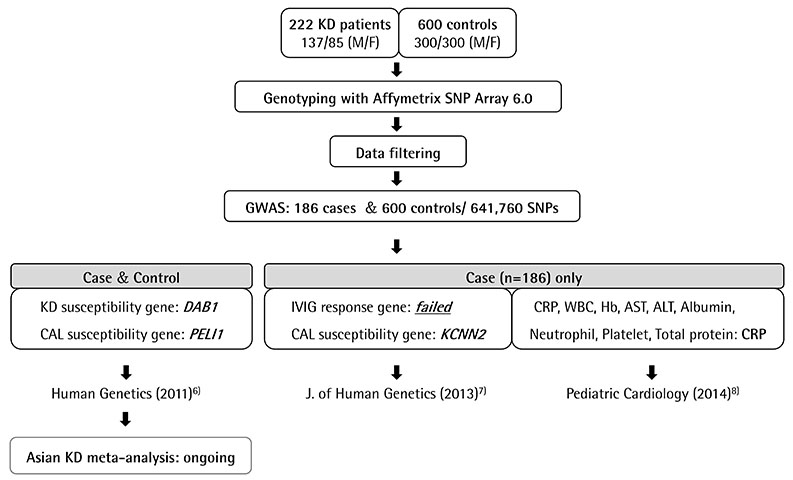Korean Circ J.
2015 Nov;45(6):443-448. 10.4070/kcj.2015.45.6.443.
Consortium-Based Genetic Studies of Kawasaki Disease in Korea: Korean Kawasaki Disease Genetics Consortium
- Affiliations
-
- 1Asan Institute for Life Sciences, University of Ulsan College of Medicine, Seoul, Korea. cookie_jklee@hotmail.com
- 2Department of Pediatrics, Ewha Womans University Hospital, Seoul, Korea.
- 3Department of Pediatrics, Korea University Hospital, Seoul, Korea.
- 4Department of Pediatrics, Chung-Ang University Hospital, Seoul, Korea.
- 5Department of Pediatrics, University of Ulsan College of Medicine, Asan Medical Center, Seoul, Korea.
- 6Department of Pediatrics, Kyung Hee University Hospital at Gangdong, Seoul, Korea.
- 7Department of Pediatrics, The Catholic University of Korea, Daejeon St. Mary's Hospital, Daejeon, Korea.
- 8Department of Pediatrics, Chungnam National University Hospital, Daejeon, Korea.
- KMID: 2223780
- DOI: http://doi.org/10.4070/kcj.2015.45.6.443
Abstract
- In order to perform large-scale genetic studies of Kawasaki disease (KD) in Korea, the Korean Kawasaki Disease Genetics Consortium (KKDGC) was formed in 2008 with 10 hospitals. Since the establishment of KKDGC, there has been a collection of clinical data from a total of 1198 patients, and approximately 5 mL of blood samples per patient (for genomic deoxyribonucleic acid and plasma isolation), using a standard clinical data collection form and a nation-wide networking system for blood sample pick-up. In the clinical risk factor analysis using the collected clinical data of 478 KD patients, it was found that incomplete KD type, intravenous immunoglobulin (IVIG) non-responsiveness, and long febrile days are major risk factors for coronary artery lesions development, whereas low serum albumin concentration is an independent risk factor for IVIG non-responsiveness. In addition, we identified a KD susceptibility locus at 1p31, a coronary artery aneurysm locus (KCNN2 gene), and the causal variant in the C-reactive protein (CRP) promoter region, as determining the increased CRP levels in KD patients, by means of genome-wide association studies. Currently, this consortium is continually collecting more clinical data and genomic samples to identify the clinical and genetic risk factors via a single nucleotide polymorphism chip and exome sequencing, as well as collaborating with several international KD genetics teams. The consortium-based approach for genetic studies of KD in Korea will be a very effective way to understand the unknown etiology and causal mechanism of KD, which may be affected by multiple genes and environmental factors.
Keyword
MeSH Terms
-
Aneurysm
C-Reactive Protein
Coronary Vessels
Data Collection
DNA
Exome
Genetics*
Genome-Wide Association Study
Humans
Immunoglobulins
Immunoglobulins, Intravenous
Korea*
Mucocutaneous Lymph Node Syndrome*
Plasma
Polymorphism, Single Nucleotide
Promoter Regions, Genetic
Risk Factors
Serum Albumin
C-Reactive Protein
DNA
Immunoglobulins
Immunoglobulins, Intravenous
Serum Albumin
Figure
Cited by 1 articles
-
ITPKC andSLC11A1 Gene Polymorphisms and Gene-Gene Interactions in Korean Patients with Kawasaki Disease
Kyu Yeun Kim, Yoon-Sun Bae, Woohyuk Ji, Dongjik Shin, Ho-Seong Kim, Dong Soo Kim
Yonsei Med J. 2018;59(1):119-127. doi: 10.3349/ymj.2018.59.1.119.
Reference
-
1. Burns JC, Glodé MP. Kawasaki syndrome. Lancet. 2004; 364:533–544.2. Newburger JW, Takahashi M, Gerber MA, et al. Diagnosis, treatment, and long-term management of Kawasaki disease: a statement for health professionals from the Committee on Rheumatic Fever, Endocarditis and Kawasaki Disease, Council on Cardiovascular Disease in the Young, American Heart Association. Circulation. 2004; 110:2747–2771.3. Kim GB, Han JW, Park YW, et al. Epidemiologic features of Kawasaki disease in South Korea: data from nationwide survey, 2009-2011. Pediatr Infect Dis J. 2014; 33:24–27.4. Kim JJ, Hong YM, Yun SW, et al. Assessment of risk factors for Korean children with Kawasaki disease. Pediatr Cardiol. 2012; 33:513–520.5. Kim HE, Kim JJ, Han MK, et al. Variations in the number of CCL3L1 gene copies and Kawasaki disease in Korean children. Pediatr Cardiol. 2012; 33:1259–1263.6. Kim JJ, Hong YM, Sohn S, et al. A genome-wide association analysis reveals 1p31 and 2p13.3 as susceptibility loci for Kawasaki disease. Hum Genet. 2011; 129:487–495.7. Kim JJ, Park YM, Yoon D, et al. Identification of KCNN2 as a susceptibility locus for coronary artery aneurysms in Kawasaki disease using genome-wide association analysis. J Hum Genet. 2013; 58:521–525.8. Kim JJ, Yun SW, Yu JJ, et al. Common variants in the CRP promoter are associated with a high C-reactive protein level in Kawasaki Disease. Pediatr Cardiol. 2015; 36:438–444.9. Khor CC, Davila S, Breunis WB, et al. Genome-wide association study identifies FCGR2A as a susceptibility locus for Kawasaki disease. Nat Genet. 2011; 43:1241–1246.10. Chang CJ, Kuo HC, Chang JS, et al. Replication and meta-analysis of GWAS identified susceptibility loci in Kawasaki disease confirm the importance of B lymphoid tyrosine kinase (BLK) in disease susceptibility. PLoS One. 2013; 8:e72037.






